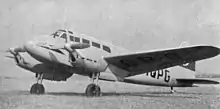Siebel Fh 104 Hallore
The Siebel Fh 104 Hallore was a small German twin-engined transport, communications and liaison aircraft built by Siebel.
| Fh 104 | |
|---|---|
 | |
| An Fh 104 with Albert Kesselring at the controls | |
| Role | Light transport, Communications, Liaison |
| National origin | Germany |
| Manufacturer | Siebel |
| First flight | 1937 |
| Primary user | Luftwaffe |
| Produced | 1937–1942 |
| Number built | 46 |
| Developed into | Siebel Si 204 |
Design and development
In 1934, the Klemm Leichtflugzeugbau set up a new factory at Halle, for production of all-metal aircraft (as opposed to Klemms normal wood and fabric light aircraft) and transferred the development of a new twin-engined transport, the Klemm Kl 104 to the Halle factory, the type being redesignated Fh 104. Klemm transferred control of the factory to Fritz Siebel in 1937, the year the Fh 104 prototype first flew.
It had a metal fuselage, plywood covered wings and a hydraulic undercarriage that retracted into the lower part of the engine nacelles. It became known as the 'Hallore' after the name given to those born in that city.
Performance
Fh 104s won long distance flying competitions in 1938 and an example flew 40,000 km around Africa in 1939. It won the principal award in the 1938 Littorio Rally.[1] During World War II the aircraft was used as a personal transport aircraft by some senior Wehrmacht officers and officials including Adolf Galland, Albert Kesselring and Ernst Udet. At least 15 aircraft appeared on the pre-war German civil register.[2] It was also used for training of Luftwaffe air crew. A Siebel Fh 104 was flown by famous German pilot and entrepreneur Beate Uhse out of Berlin during the final days of World War II.[3]
The larger Siebel Si 204 was based on it.
Operators

- Czechoslovakian Air Force (Postwar)
- Luftwaffe
Specifications (Fh 104A)
Data from German Aircraft of the Second World War,[4][5] Jane's All the World's Aircraft 1938[1]
General characteristics
- Crew: 1 or 2
- Capacity: up to 5 passengers
- Length: 9.5 m (31 ft 2 in)
- Wingspan: 12.06 m (39 ft 7 in)
- Height: 2.58 m (8 ft 6 in)
- Wing area: 22.3 m2 (240 sq ft)
- Empty weight: 1,440 kg (3,175 lb)
- Gross weight: 2,250 kg (4,960 lb)
- Fuel capacity: 320 L (85 US gal; 70 imp gal) fuel; 25 L (6.6 US gal; 5.5 imp gal) oil
- Powerplant: 2 × Hirth HM 508D V-8 inverted air-cooled piston engines 280 PS (280 hp; 210 kW)
- Propellers: 2-bladed variable-pitch propellers, 2.35 m (7 ft 9 in) diameter
Performance
- Maximum speed: 350 km/h (220 mph, 190 kn) at sea level
- Cruise speed: 300 km/h (190 mph, 160 kn) at sea level
- 99 km/h (62 mph; 53 kn)
- Landing speed: 97 km/h (60 mph; 52 kn) at 2,500 m (8,202 ft)
- Range: 1,000 km (620 mi, 540 nmi) at 2,500 m (8,202 ft)
- Service ceiling: 6,600 m (21,700 ft)
- 1,600 m (5,249 ft) on one engie
- Rate of climb: 9.8 m/s (1,930 ft/min)
- Time to altitude: 1,000 m (3,281 ft) in 2 minute 48 seconds
- 3,000 m (9,843 ft) in 10 minute 42 seconds
- Wing loading: 101 kg/m2 (21 lb/sq ft)
- Power/mass: 0.1596 kW/kg (0.0971 hp/lb)
References
- Grey, C.G.; Bridgman, Leonard, eds. (1938). Jane's All the World's Aircraft 1938. London: Sampson Low, Marston & company, ltd. pp. 165c–166c.
- "Civil Aircraft Register - Germany". www.airhistory.org.uk. Retrieved 28 November 2019.
- In German: http://www.airventure.de/history.html
- Smith and Kay 1990, p.581.
- Nowarra, Heinz J. (1993). Die Deutsche Luftrüstung 1933–1945 Vol.4 – Flugzeugtypen MIAG-Zeppelin (in German). Koblenz: Bernard & Graefe Verlag. pp. 26–27, 46–47. ISBN 3-7637-5468-7.
Bibliography
- Smith, J.R. and Kay, Antony J. German Aircraft of the Second World War. London:Putnam, 1990. ISBN 0-85177-836-4.